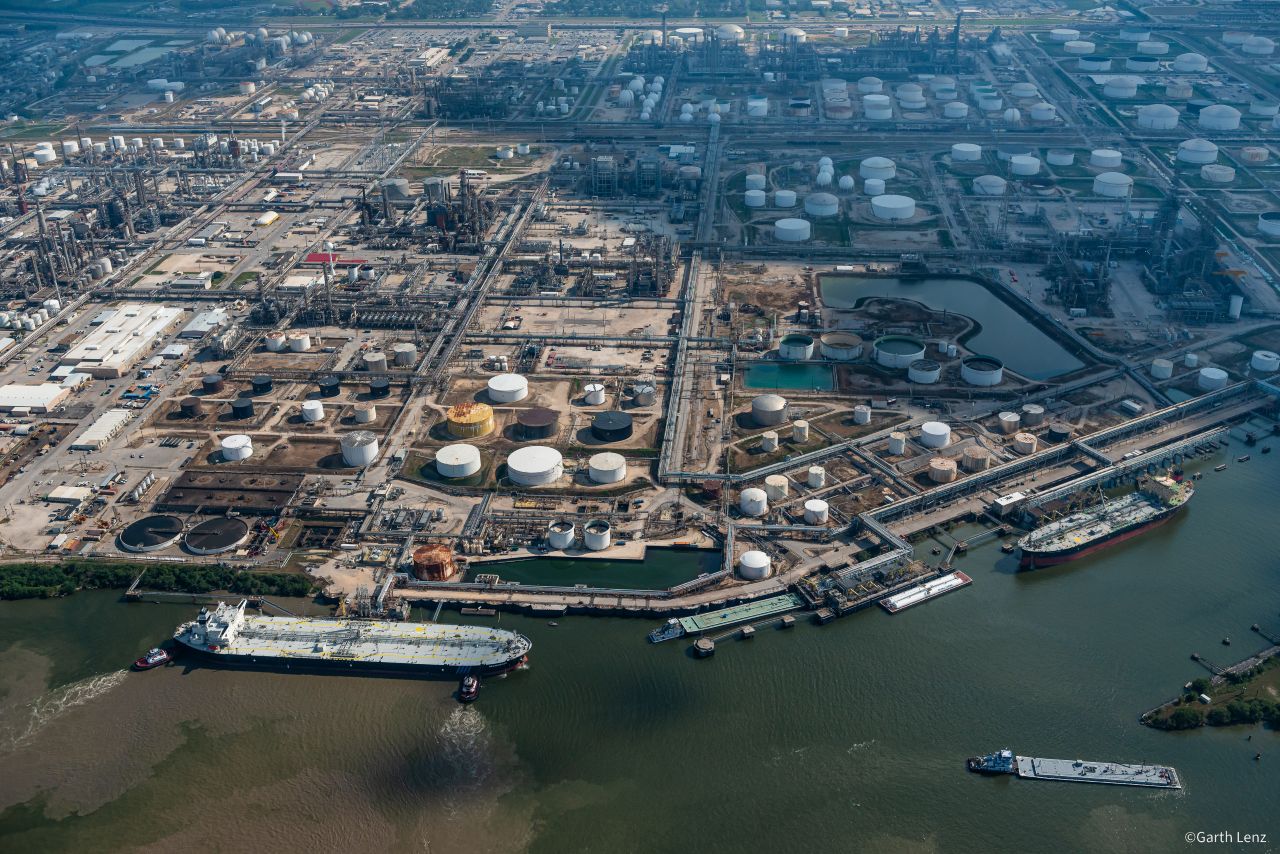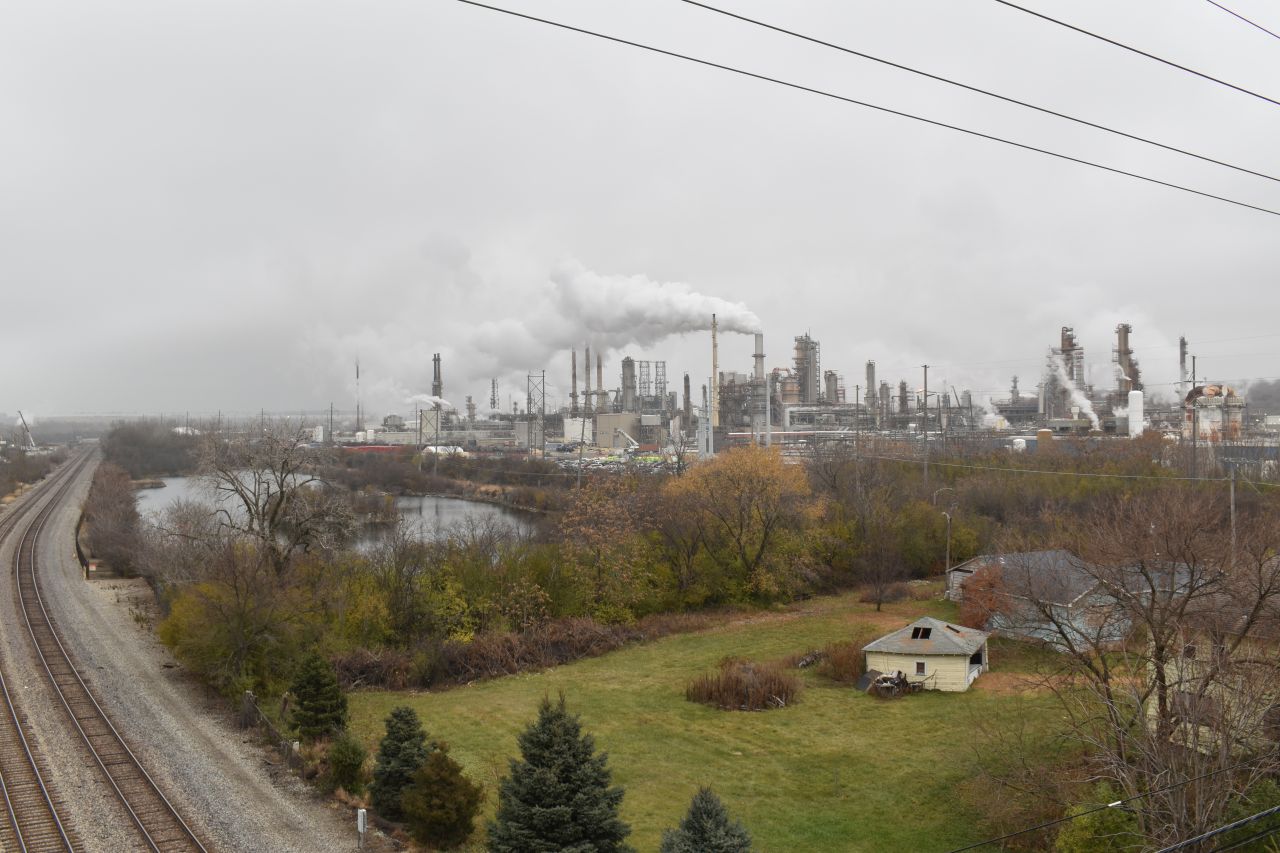Houston smog worst in 12 years, hitting Latino, Black and lower-income neighborhoods hardest

Driven by the hottest summer on record and air pollution from the oil and gas industry, the Houston region in 2023 suffered its worst year for smog in more than a decade – with air pollution hitting hardest in Latino, Black, and lower-income neighborhoods, according to a new report by the Environmental Integrity Project (EIP).
Air monitoring data show that Houston’s air quality violated health-based standards on 55 days in 2023, more than any other year since 2011, according to the report and an interactive online data map. Scorching temperatures combined with emissions, in part from vehicles, oil refineries, chemical plants, and other sources, triggered a rise in ozone across the region, which includes Harris, Galveston, Brazoria, and Montgomery counties.
Although smoggy air affects almost everyone, Houston air monitoring data show some neighborhoods were hurt more by high ozone levels in 2023, according to EIP’s analysis. People of color and low-income households were more likely to live in locations that had higher and more persistent ozone levels in recent years and over the longer term.
“This report reveals the worsening ozone levels and the deepening environmental injustices prevalent in our communities of color who continue to bear the greatest impact of ozone pollution,” said Dr. Inyang Uwak, research and policy director at Air Alliance Houston.
Dr. Loren Hopkins, Chief Environmental Science Officer for the Houston Health Department, said: “The Houston Health Department is very concerned about these high ozone levels, not only because they occur in environmental justice communities, but also because these same communities suffer from asthma attacks and cardiac arrest at higher rates than the rest of the city.”
The state of Texas is aggravating the problem by approving permits for the construction of more oil and gas related plants that would release more air pollution. At least 22 new industrial projects have been proposed since 2016 and, if approved, could release more than 12,000 additional tons of smog-forming chemicals in the greater Houston area. The state has also turned a blind eye to the pollution from hundreds of “emission events” every year that escape enforcement because industries claim they are “unpreventable.”


Ground-level ozone, also known as smog, is formed by the reaction between nitrogen oxide and volatile organic chemicals (VOC’s) under bright sunlight and high temperatures. While all VOC’s contribute to ozone formation, petrochemicals are a major source of the subset of “highly reactive” VOC’s that speed up that process It irritates and damages the lungs and has long been proven to worsen chronic health conditions such as asthma, emphysema, and bronchitis. Newer studies suggest that long-term exposure to ozone actually causes asthma, not merely worsens symptoms in those who already have the disease, and also contributes to premature mortality.
To view the full report on ozone in the Houston region over the last 16 years, click on this link. In-depth, interactive maps with data and demographics showing which neighborhoods experienced the worst effects of this year’s smog pollution are available here.
The report, which is based on monitoring data compiled by the Texas Commission on Environmental Quality, details a recurring smog problem in the Houston region over the last decade, with communities of color and low-income neighborhoods experiencing disproportionately worse air pollution and often increasing ozone.
In 2023, six locations have recorded eight-hour ozone levels of 100 part per billion (ppb) or greater, which is far above the current health standard of 70 ppb. People of color — predominately Latino and African American — accounted for more than 90 percent of residents within three miles of four of these locations, including Houston East, in the Galena Park community, and Clinton, in the Clinton Park neighborhood. About half the people surrounding these four monitors east of Houston live in low-income households.

Although a record-breaking hot summer in the Houston area drove ozone levels higher this year, climate forecasters predict temperatures will continue to rise as global warming advances.
To protect the public from worsening air quality in cities and industrial zones during the mid-20th Century, Congress in 1970 passed the Clean Air Act to regulate harmful pollutants like smog. The EPA has gradually tightened ozone standards over the past 15 years in response to scientific evidence about the damage caused by ozone. The Bush Administration adopted a 2008 standard to keep ozone concentrations averaged over eight hours at or below 75 parts per billion (ppb), which the Obama Administration reduced to 70 ppb in 2015. The 2008 and 2015 standards are still in effect, and the Houston area is out of compliance with both.
Air quality monitors in the Houston area and elsewhere across the U.S. identify the highest eight-hour concentration of ozone for each day. A county or metropolitan area violates the Clean Air Act’s health-based standard whenever the three-year average of the fourth highest ozone concentration in each year exceeds the applicable limit.
For example, the fourth highest 8-hour ozone observed at the Park Place monitor in Harris County, southeast of Houston, was 78 parts per billion in 2021, 72 ppb in 2022, and 85 ppb in 2023, yielding a 3-year average of 78 ppb that violates both the 2008 and 2015 standards.
EIP’s analysis shows that after a decline in the 1990s and early 2000s, Houston’s smog problem has been worsening recently. Ozone levels at six of the locations that exceeded the 2008 (75 ppb) standard in 2021–2023 are either unchanged or higher than the three-year average in 2008–2010. The percentage of people of color and those with low income who live near these places are far higher than either the state or county average.
The report also documents how many days the ozone standard was exceeded at various locations in the greater Houston area, as every day with high ozone levels is bad for public health. The ten locations that recorded the most violations of the ozone limits between 2021 and 2023 all had at least 29 days where ozone levels exceeded the standard, with the highest being 49 days at the Houston Bayland Park location. Again, people of color make a disproportionate share of the population within three miles of locations recording the most frequent violations of the 70 ppb ozone limit
Texas leaders have long been reluctant to address Houston’s unhealthy air. For example, in an Oct. 12 letter to the Biden Administration, Texas Gov. Greg Abbott complained to the EPA about the need to formally designate the air quality in Houston, Dallas-Fort Worth, and San Antonio as “serious” for failing to meet the ozone standard.
Blaming the EPA for what he called a “unreasonably compressed timeline” for Texas to submit plans to improve air quality, Abbott warned of “potential sanctions and federal implementation plans that could have lasting detrimental impacts to industry in our state.” The letter did not mention public health or the cost of existing poor air quality due to excess deaths or days of missed work or school due to asthma attacks.
Dr. Uwak with Air Alliance Houston said the group’s community air monitoring efforts in several of the areas hardest hit by smog pollution “confirm these alarming trends, emphasizing the dire need for our state regulatory agency to take a more proactive approach to address Houston’s smog problem.”
Dr. Loren Hopkins, chief environmental science officer for the Houston Health Department, noted that industry emissions of the chemicals that combine to form ozone could be more tightly regulated by the TCEQ. “We continue to seek out emissions sources of pollutants that are the precursors to ozone, such as formaldehyde, benzene, and 1,3-butadiene,” Dr. Hopkins said. “We would welcome TCEQ working with us to lower these ozone precursors.”
Lead photo: The Houston skyline on a smoggy day. Photo by iStockphoto.















